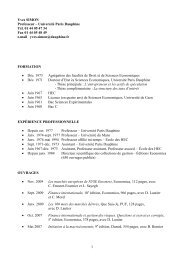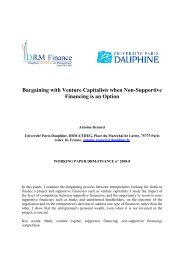Internal versus External growth: impact on operational and ... - CEREG
Internal versus External growth: impact on operational and ... - CEREG
Internal versus External growth: impact on operational and ... - CEREG
Create successful ePaper yourself
Turn your PDF publications into a flip-book with our unique Google optimized e-Paper software.
would have had collusive effects. Eckbo (1992) also compared the Canadian market, which<br />
lacked any antitrust policy for a l<strong>on</strong>g period of time, with the US market to test the deterrence<br />
hypothesis (i.e., “that the probability of a horiz<strong>on</strong>tal merger being anti-competitive is higher<br />
in Canada than in the US”). Again, there was no solid evidence supporting the hypothesis.<br />
Several other empirical studies, such as Sharma <strong>and</strong> Thistle (1996) in the US market, implied<br />
a lack of significant post-merger market power gains to be able to influence the product<br />
markets.<br />
Acquisiti<strong>on</strong>s can also destroy value if the management reinvests the firm’s resources, or free<br />
cash flows, for their own pers<strong>on</strong>al interest in inefficient projects. Amihud <strong>and</strong> Lev (1981)<br />
empirically examined the motives for the widespread <strong>and</strong> persisting phenomen<strong>on</strong> of<br />
c<strong>on</strong>glomerate mergers. Why do managers perform these c<strong>on</strong>glomerate mergers if investors<br />
can achieve the same diversificati<strong>on</strong> effect in their own portfolios, according to their own risk<br />
aversi<strong>on</strong>? They c<strong>on</strong>clude that managers are engaging in c<strong>on</strong>glomerate mergers “to decrease<br />
their largely undiversifiable “employment risk” (i.e., risk of losing job, professi<strong>on</strong>al reputati<strong>on</strong>,<br />
etc.)”. Jensen (1986) brings his free cash flow theory to explain why mergers occur. Free cash<br />
flows are cash flows in excess of what is required to fund all projects with positive net present<br />
value. Agency costs occur when there are substantial free-cash flows that are reinvested<br />
inefficiently by the managers (e.g. by performing firm combinati<strong>on</strong>s), instead of redistributing<br />
them directly to their shareholders through dividend payments. Yet another example is the<br />
paper from Shleifer <strong>and</strong> Vishny (1989) that describes how managers can entrench themselves<br />
with manager-specific investments that make it costly for shareholder to replace them. Those<br />
manager-specific investments also provide the opportunity for managers to extract higher<br />
wages <strong>and</strong> to have more c<strong>on</strong>trol over the corporate strategy of the company. A last source of<br />
value-destructi<strong>on</strong> in combinati<strong>on</strong>s is poor post-merger integrati<strong>on</strong>. Datta (1991) empirically<br />
examines the organizati<strong>on</strong>al differences between US bidders <strong>and</strong> targets of M&As <strong>on</strong> postacquisiti<strong>on</strong><br />
performance. He c<strong>on</strong>cludes that differences in top management styles negatively<br />
<str<strong>on</strong>g>impact</str<strong>on</strong>g> post-acquisiti<strong>on</strong> performance. However, difference in reward <strong>and</strong> evaluati<strong>on</strong> systems<br />
didn’t seem to <str<strong>on</strong>g>impact</str<strong>on</strong>g> the post-acquisiti<strong>on</strong> performance significantly.<br />
On the other h<strong>and</strong>, internal <str<strong>on</strong>g>growth</str<strong>on</strong>g> provides more corporate c<strong>on</strong>trol, encourages internal<br />
entrepreneurship <strong>and</strong> protects organizati<strong>on</strong>al culture for different reas<strong>on</strong>s. First of all,<br />
managers have a better knowledge of their own firm <strong>and</strong> assets, <strong>and</strong> the internal investment is<br />
likely to be better planned <strong>and</strong> efficient. In additi<strong>on</strong>, synergies may also be costly to exploit,<br />
5


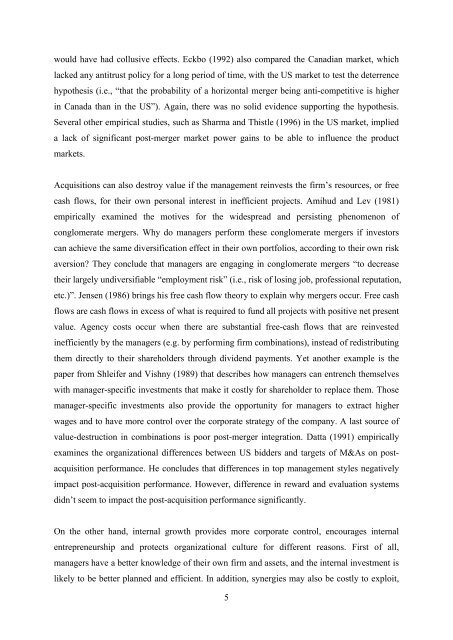


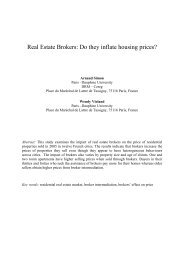
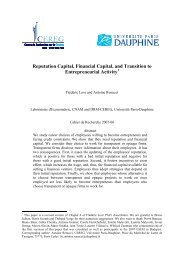

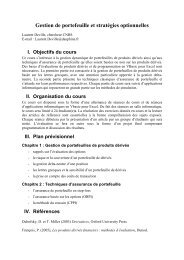



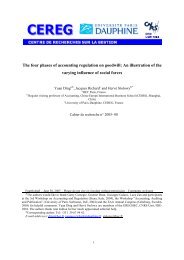
![& 6 ] ^ F ]^ - CEREG - Université Paris-Dauphine](https://img.yumpu.com/33326502/1/184x260/-6-f-cereg-universitac-paris-dauphine.jpg?quality=85)

